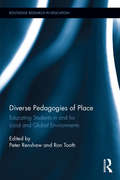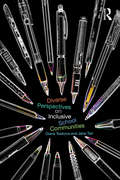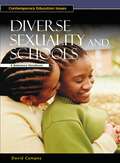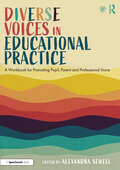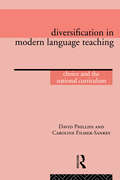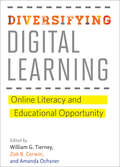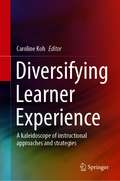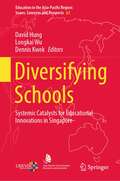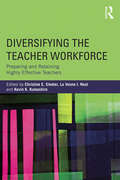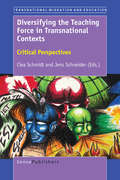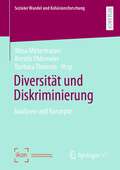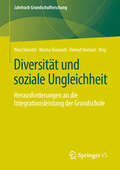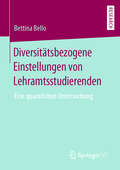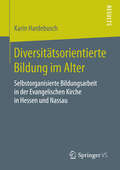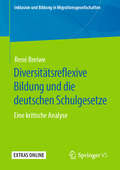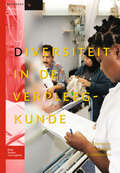- Table View
- List View
Diverse Pedagogies of Place: Educating Students in and for Local and Global Environments (Routledge Research in Education)
by Peter Renshaw Ron ToothDiverse Pedagogies of Place presents eight original place-responsive pedagogies that address a question of paramount importance in today’s world: how do we educate the next generation of students to confront the challenges of global climate change and the on-going degradation of natural environments? Each place-responsive pedagogy is a result of innovative environmental educators’ long-term engagement with particular places, and demonstrates that personal connectedness is crucial to effective environmental education. Professional learning and teacher collaboration is an important theme throughout the book, and the editors discuss how teachers could adapt the learning activities and teaching strategies found in the book in order to create their own place-responsive pedagogies. Each case study provides a rich account of how students can learn to be attentive and draws upon a common analytical framework derived from recent theorisation of place that highlights the centrality of stories-in-place, embodiment, and contestation. The authors present detailed and persuasive evidence that place-responsive pedagogies enable students to construct their own identities, as well as develop commitments and a deeper knowledge of the environments that surround them. A work of international relevance, Diverse Pedagogies of Place will appeal to academics, researchers and postgraduate students in the fields of environmental education and sustainability, place-based education, outdoor learning, professional learning and teacher development, as well as policymakers and environmental educators.
Diverse Pedagogies of Place: Educating Students in and for Local and Global Environments (Routledge Research in Education)
by Peter Renshaw Ron ToothDiverse Pedagogies of Place presents eight original place-responsive pedagogies that address a question of paramount importance in today’s world: how do we educate the next generation of students to confront the challenges of global climate change and the on-going degradation of natural environments? Each place-responsive pedagogy is a result of innovative environmental educators’ long-term engagement with particular places, and demonstrates that personal connectedness is crucial to effective environmental education. Professional learning and teacher collaboration is an important theme throughout the book, and the editors discuss how teachers could adapt the learning activities and teaching strategies found in the book in order to create their own place-responsive pedagogies. Each case study provides a rich account of how students can learn to be attentive and draws upon a common analytical framework derived from recent theorisation of place that highlights the centrality of stories-in-place, embodiment, and contestation. The authors present detailed and persuasive evidence that place-responsive pedagogies enable students to construct their own identities, as well as develop commitments and a deeper knowledge of the environments that surround them. A work of international relevance, Diverse Pedagogies of Place will appeal to academics, researchers and postgraduate students in the fields of environmental education and sustainability, place-based education, outdoor learning, professional learning and teacher development, as well as policymakers and environmental educators.
Diverse Perspectives on Inclusive School Communities
by Diana Tsokova Jane TarrWhat is an inclusive school community? How do stakeholders perceive their roles and responsibilities towards inclusive school communities? How can school communities become more inclusive through engagement with individual perspectives? Diverse Perspectives on Inclusive School Communities captures and presents the voices of a wide range of stakeholders including young people and their parents, teachers, support staff, educational psychologists, social workers, health practitioners and volunteers in producing a collection of varied perspectives on inclusive education. In this fascinating book, Tsokova and Tarr uniquely assemble a compilation of accounts collected through in-depth interviews with over twenty-five participants, met throughout the course of their professional lives. The authors focus on how we can ensure all children receive the best education and social provision in inclusive school communities. Key learning points in this book emphasise: links between early life and educational experiences; constructions of inclusion; an understanding of roles and responsibilities; the power of agency in relation to inclusive school communities. The text contributes to current debates surrounding educational policy initiatives, highlighting similarities and differences across people and professions, and illuminating a way forward for the consideration of a broader range of insight into the concept of inclusion and ways this can be achieved. Including both UK and international perspectives that illustrate different stages of the inclusive education process, this text will be invaluable to anyone affiliated with inclusive schooling in a personal or professional capacity.
Diverse Perspectives on Inclusive School Communities
by Diana Tsokova Jane TarrWhat is an inclusive school community? How do stakeholders perceive their roles and responsibilities towards inclusive school communities? How can school communities become more inclusive through engagement with individual perspectives? Diverse Perspectives on Inclusive School Communities captures and presents the voices of a wide range of stakeholders including young people and their parents, teachers, support staff, educational psychologists, social workers, health practitioners and volunteers in producing a collection of varied perspectives on inclusive education. In this fascinating book, Tsokova and Tarr uniquely assemble a compilation of accounts collected through in-depth interviews with over twenty-five participants, met throughout the course of their professional lives. The authors focus on how we can ensure all children receive the best education and social provision in inclusive school communities. Key learning points in this book emphasise: links between early life and educational experiences; constructions of inclusion; an understanding of roles and responsibilities; the power of agency in relation to inclusive school communities. The text contributes to current debates surrounding educational policy initiatives, highlighting similarities and differences across people and professions, and illuminating a way forward for the consideration of a broader range of insight into the concept of inclusion and ways this can be achieved. Including both UK and international perspectives that illustrate different stages of the inclusive education process, this text will be invaluable to anyone affiliated with inclusive schooling in a personal or professional capacity.
Diverse Sexuality and Schools: A Reference Handbook (Contemporary Education Issues)
by David CamposAn overview of the gay, lesbian, bisexual, and transgender (GLBT) students in our schools—what they endure, their special needs, and the programs and groups that support them.Diverse Sexuality and Schools: A Reference Handbook is an eye-opening report on gay, lesbian, bisexual, and transgender youth in our schools—the isolation they feel, the hostilities they face, their unique developmental and emotional needs, and the innovative ways schools, communities, and organizations are working to support them.Author David Campos offers a compelling, often harrowing, tour of the lives of GLBT students, including what researchers have learned over the past half-century and what the schools, the courts, and the government are doing to keep them safe regardless of their sexual orientation. But perhaps the book's greatest impact comes from the way Campos gives voice to this often neglected population, providing a forum for these students' painful testimonies of harassment, violence, and despair.
Diverse Voices in Educational Practice: A Workbook for Promoting Pupil, Parent and Professional Voice
by Alexandra SewellThis practical workbook supports teachers seeking to sensitively understand and respond to the opinions and perceptions of critical stakeholders in student learning and development; pupil voice, parent voice, and professional voice are introduced and explored. A wide range of expert educator and academic contributors ensure that diverse voices are meaningfully understood, with chapters placing an emphasis on minority and traditionally marginalised groups, including SEND, LGBTQIA+, and Global Majority students. The workbook advocates a clear and inclusive ethos and demonstrates how voice work can help to decolonise the curriculum, promote a positive LGBTQIA+ friendly school climate, and value pupil involvement. Moments for personal reflection, activities, and action plans allow practitioners to consider the role they play in facilitating the effective inclusion of those not normally involved in knowledge construction and decision-making processes. Blending key theory with practical strategies and takeaways, this workbook is an essential tool for practising primary and secondary teachers and teaching assistants, as well as educational psychologists, school counsellors, and other educational professionals interested in promoting inclusive voice practices.
Diverse Voices in Educational Practice: A Workbook for Promoting Pupil, Parent and Professional Voice
by Alexandra SewellThis practical workbook supports teachers seeking to sensitively understand and respond to the opinions and perceptions of critical stakeholders in student learning and development; pupil voice, parent voice, and professional voice are introduced and explored. A wide range of expert educator and academic contributors ensure that diverse voices are meaningfully understood, with chapters placing an emphasis on minority and traditionally marginalised groups, including SEND, LGBTQIA+, and Global Majority students. The workbook advocates a clear and inclusive ethos and demonstrates how voice work can help to decolonise the curriculum, promote a positive LGBTQIA+ friendly school climate, and value pupil involvement. Moments for personal reflection, activities, and action plans allow practitioners to consider the role they play in facilitating the effective inclusion of those not normally involved in knowledge construction and decision-making processes. Blending key theory with practical strategies and takeaways, this workbook is an essential tool for practising primary and secondary teachers and teaching assistants, as well as educational psychologists, school counsellors, and other educational professionals interested in promoting inclusive voice practices.
Diversification in Modern Language Teaching: Choice and the National Curriculum
by Caroline Filmer-Sankey David PhillipsAs the effects of European integration become more widely felt the effective teaching of modern languages is moving towards the centre of the educational agenda and more and more schools are considering starting pupils on a first foreign language other than French - a development encouraged by the National Curriculum orders in Modern Languages. Diversification in Modern Language Teaching gives language teachers and heads of department the evidence upon which to decide if diversification is right for them. It looks at the factors which effect children's learning in this area and at the managerial issues both within and outside the school. Throughout it argues that the decision must be a purely educational one, based on pupil motivation and accessibility as well as on particular local strengths among staff and parents.
Diversification in Modern Language Teaching: Choice and the National Curriculum
by Caroline Filmer-Sankey David PhillipsAs the effects of European integration become more widely felt the effective teaching of modern languages is moving towards the centre of the educational agenda and more and more schools are considering starting pupils on a first foreign language other than French - a development encouraged by the National Curriculum orders in Modern Languages. Diversification in Modern Language Teaching gives language teachers and heads of department the evidence upon which to decide if diversification is right for them. It looks at the factors which effect children's learning in this area and at the managerial issues both within and outside the school. Throughout it argues that the decision must be a purely educational one, based on pupil motivation and accessibility as well as on particular local strengths among staff and parents.
Diversifying Digital Learning: Online Literacy and Educational Opportunity (Tech.edu: A Hopkins Series on Education and Technology)
by William G. Tierney Zo;« B. Corwin Amanda OchsnerMany schools and programs in low-income neighborhoods lack access to the technological resources, including equipment and Internet service, that those in middle- and upper-income neighborhoods have at their fingertips. This inequity creates a persistent digital divide;¢;‚¬;€?not a simple divide in access to technology per se, but a divide in both formal and informal digital literacy that further marginalizes youths from low-income, minoritized, and first-generation communities.Diversifying Digital Learning outlines the pervasive problems that exist with ensuring digital equity and identifies successful strategies to tackle the issue. Bringing together top scholars to discuss how digital equity in education might become a key goal in American education, this book is structured to provide a framework for understanding how historically underrepresented students most effectively engage with technology;¢;‚¬;€?and how institutions may help or hinder students;€™ ability to develop and capitalize on digital literacies.This book will appeal to readers who are well versed in the diverse uses of social media and technologies, as well as less technologically savvy educators and policy analysts in educational organizations such as schools, afterschool programs, colleges, and universities. Addressing the intersection of digital media, race/ethnicity, and socioeconomic class in a frank manner, the lessons within this compelling work will help educators enable students in grades K;€“12, as well as in postsecondary institutions, to participate in a rapidly changing world framed by shifting new media technologies.Contributors: Young Whan Choi, Zo;« B. Corwin, Christina Evans, Julie Flapan, Joanna Goode, Erica Hodgin, Joseph Kahne, Suneal Kolluri, Lynette Kvasny, David J. Leonard, Jane Margolis, Crystle Martin, Safiya Umoja Noble, Amanda Ochsner, Fay Cobb Payton, Antar A. Tichavakunda, William G. Tierney, S. Craig Watkins
Diversifying Digital Learning: Online Literacy and Educational Opportunity (Tech.edu: A Hopkins Series on Education and Technology)
by William G. Tierney Zo;« B. Corwin Amanda OchsnerMany schools and programs in low-income neighborhoods lack access to the technological resources, including equipment and Internet service, that those in middle- and upper-income neighborhoods have at their fingertips. This inequity creates a persistent digital divide;¢;‚¬;€?not a simple divide in access to technology per se, but a divide in both formal and informal digital literacy that further marginalizes youths from low-income, minoritized, and first-generation communities.Diversifying Digital Learning outlines the pervasive problems that exist with ensuring digital equity and identifies successful strategies to tackle the issue. Bringing together top scholars to discuss how digital equity in education might become a key goal in American education, this book is structured to provide a framework for understanding how historically underrepresented students most effectively engage with technology;¢;‚¬;€?and how institutions may help or hinder students;€™ ability to develop and capitalize on digital literacies.This book will appeal to readers who are well versed in the diverse uses of social media and technologies, as well as less technologically savvy educators and policy analysts in educational organizations such as schools, afterschool programs, colleges, and universities. Addressing the intersection of digital media, race/ethnicity, and socioeconomic class in a frank manner, the lessons within this compelling work will help educators enable students in grades K;€“12, as well as in postsecondary institutions, to participate in a rapidly changing world framed by shifting new media technologies.Contributors: Young Whan Choi, Zo;« B. Corwin, Christina Evans, Julie Flapan, Joanna Goode, Erica Hodgin, Joseph Kahne, Suneal Kolluri, Lynette Kvasny, David J. Leonard, Jane Margolis, Crystle Martin, Safiya Umoja Noble, Amanda Ochsner, Fay Cobb Payton, Antar A. Tichavakunda, William G. Tierney, S. Craig Watkins
Diversifying Learner Experience: A kaleidoscope of instructional approaches and strategies
by Caroline KohThis book brings together strategies and innovations that educators from diverse educational contexts have conceptualized and implemented to cater to differences in academic ability, as well as in other domains such as psychosocial contexts and developmental needs. The emergence of IT and new technologies have altered the educational landscape and opened a multitude of opportunities for diverse modes of instruction catering to diverse student populations.The book addresses the gap in the literature with evidence-based reports of innovative strategies and approaches that are grounded in educational research. It identifies student differences in terms of academic ability and also, with regard to their cultural and social background, their developmental and psycho-emotional needs. It examines how new technologies are used in instructional approaches and how these innovative strategies diversify learner experiences. The book is a valuable resource to practitioners, researchers and educational administrators.
Diversifying Schools: Systemic Catalysts for Educational Innovations in Singapore (Education in the Asia-Pacific Region: Issues, Concerns and Prospects #61)
by David Hung Longkai Wu Dennis KwekThis book discusses the strategies that the Singapore Education System has embarked to encourage school change and innovations. It documents the change journey of Specialized Schools and Future Schools in Singapore with a view to understand the key tenets that enable school wide change and reform. The intents for change and reform are to anchor the education system to the basic foundations and principles of education and yet enable the system as a whole to be malleable to change and globalization. It shows how Singapore enables diversity within a structured environment through innovations in Specialized and Future Schools, and highlights the systemic rationale behind various efforts in Specialized and Future Schools and the kinds of adaptations schools have made to leverage structures and make adjustments for their contexts.
Diversifying the Teacher Workforce: Preparing and Retaining Highly Effective Teachers
by Christine E. Sleeter La Vonne Neal Kevin K. KumashiroDiversifying the Teacher Workforce critically examines efforts to diversify the teaching force and narrow the demographic gap between who teaches and who populates U.S. classrooms. While the demographic gap is often invoked to provide a needed rationale for preparing all teachers, and especially White teachers, to work with students of color, it is far less often invoked in an effort to examine why the teaching force remains predominantly White in the first place. Based on work the National Association for Multicultural Education is engaged in on this phenomenon, this edited collection brings together leading scholars to look closely at this problem. They examine why the teaching force is predominantly White from historical as well as contemporary perspectives, showcase and report available data on a variety of ways this problem is being tackled at the pre-service and teacher credentialing levels, and examine how a diverse and high-quality teaching force can be retained and thrive. This book is an essential resource for any educator interested in exploring race within the context of today’s urban schools.
Diversifying the Teacher Workforce: Preparing and Retaining Highly Effective Teachers
by Christine E. Sleeter La Vonne Neal Kevin K. KumashiroDiversifying the Teacher Workforce critically examines efforts to diversify the teaching force and narrow the demographic gap between who teaches and who populates U.S. classrooms. While the demographic gap is often invoked to provide a needed rationale for preparing all teachers, and especially White teachers, to work with students of color, it is far less often invoked in an effort to examine why the teaching force remains predominantly White in the first place. Based on work the National Association for Multicultural Education is engaged in on this phenomenon, this edited collection brings together leading scholars to look closely at this problem. They examine why the teaching force is predominantly White from historical as well as contemporary perspectives, showcase and report available data on a variety of ways this problem is being tackled at the pre-service and teacher credentialing levels, and examine how a diverse and high-quality teaching force can be retained and thrive. This book is an essential resource for any educator interested in exploring race within the context of today’s urban schools.
Diversifying the Teaching Force in Transnational Contexts: Critical Perspectives (Transnational Migration and Education)
by Clea Schmidt Jens Schneider"Diversifying the teaching force has become a priority in many migrant-receiving jurisdictions worldwide with the growing mismatch between the ethnic backgrounds, cultures, languages, and religions of teachers and those of students and families. Arguments for diversification tend to be couched in terms of disproportionate representation and students from minority backgrounds needing positive role models, yet research identifies other compelling reasons for diversification, including the fact that teachers of migrant backgrounds often possess outstanding qualifications when multilingualism and internationally obtained education and experience are taken into account, and the fact that all students, including majority-background students, benefit from a diversity of role models in schools. Nevertheless, the process of diversification is fraught with complexity. Depending on the context, systemic discrimination, an oversupply of teachers in the profession generally, and outdated hiring policies and practices can all impede efforts to diversify the teaching force.This volume comprises original research from Canada, the U.S., Germany, Ireland, Scotland, and England that problematizes issues of diversifying the teaching force and identifies promising practices. A foreword written by Charlene Bearhead of the National Centre for Truth and Reconciliation questions the very purpose of education in and for diverse societies. An introduction written by the editors defines key concepts and establishes a rationale for diversifying the teaching force in migrant-receiving contexts. Following this, key international scholars offer empirical perspectives using a range of methodologies and theories rooted in critical social science paradigms. The volume informs future research, programming, and policy development in this area."
Diversifying the Teaching Profession: Dimensions, Dilemmas and Directions for the Future (Routledge Research in Educational Equality and Diversity)
by Elaine Keane Manuela Heinz Rory Mc DaidThis edited volume is about diversifying the teaching profession. It is unique in its inclusion of multiple dimensions of diversity; its chapters focus on a wide range of under-represented groups, including those from lower socio-economic groups, Black and minority ethnic groups, migrants, the Travelling community, the Deaf community, the LGBTQI+ community and those of mature age.The book includes contributions from Australia, England, Iceland, Portugal and Scotland, as well as a number of chapters from the Irish context, mostly emanating from projects funded under Ireland’s Higher Education Authority’s Programme for Access to Higher Education (PATH): Strand 1—Equity of Access to Initial Teacher Education.The book also critically engages the rationale for diversifying the profession, arguing not only that representation still matters, but also that ultimately teacher diversity work needs to encompass system transformation to achieve a diverse, equitable and inclusive teaching profession.The Open Access version of this book, available at http://www.taylorfrancis.com, has been made available under a Creative Commons Attribution-Non Commercial-No Derivatives (CC-BY-NC-ND) 4.0 license.
Diversifying the Teaching Profession: Dimensions, Dilemmas and Directions for the Future (Routledge Research in Educational Equality and Diversity)
by Elaine Keane Manuela Heinz Rory Mc DaidThis edited volume is about diversifying the teaching profession. It is unique in its inclusion of multiple dimensions of diversity; its chapters focus on a wide range of under-represented groups, including those from lower socio-economic groups, Black and minority ethnic groups, migrants, the Travelling community, the Deaf community, the LGBTQI+ community and those of mature age.The book includes contributions from Australia, England, Iceland, Portugal and Scotland, as well as a number of chapters from the Irish context, mostly emanating from projects funded under Ireland’s Higher Education Authority’s Programme for Access to Higher Education (PATH): Strand 1—Equity of Access to Initial Teacher Education.The book also critically engages the rationale for diversifying the profession, arguing not only that representation still matters, but also that ultimately teacher diversity work needs to encompass system transformation to achieve a diverse, equitable and inclusive teaching profession.The Open Access version of this book, available at http://www.taylorfrancis.com, has been made available under a Creative Commons Attribution-Non Commercial-No Derivatives (CC-BY-NC-ND) 4.0 license.
Diversität und Digitalität in der Hochschullehre: Innovative Formate in digitalen Bildungskulturen (Hochschulbildung: Lehre und Forschung #8)
by Lorenz Mrohs Konstantin Lindner Theresia Witt Carmen Herrmann Hannah Brodel Ilona MaidanjukWas kennzeichnet studentische Diversität? Wie kann Digitalität Wege bereiten, um die vielfältigen Bedürfnisse von Studierenden stärker zu adressieren? Die Beiträger*innen bündeln Erkenntnisse bezüglich eines innovativen Umgangs mit Diversität in der Hochschullehre. Dabei stehen digitale Lehr-, Lern-, Prüfungs- und Beratungsformate im Zentrum, welche die Qualität der Lehre stetig verbessern. Somit entstehen neue, intersektionale Ideen für Wissenschaftler*innen und Hochschullehrende, die studentischer Diversität mit digitalen Kulturen begegnen wollen.
Diversität und Diskriminierung: Analysen und Konzepte (Sozialer Wandel und Kohäsionsforschung)
by Mina Mittertrainer Kerstin Oldemeier Barbara ThiessenDiversität gilt heute in Bildungsinstitutionen, sozialen Einrichtungen oder Unternehmen nicht nur als selbstverständlich, sondern auch als Bereicherung und bedeutsam für Kreativität in Teams. Gleichwohl geht mit Diversität immer noch Diskriminierung in unterschiedlichen Formen und Intensitäten einher. Zu fragen ist, welche Dynamiken hier wirksam sind und wie diese Verbindung zu kappen wäre. Zentrales Anliegen des Sammelbandes ist daher, Diversität als komplexe Kategorie mit interdisziplinären Zugängen und aus machtkritischer Perspektive zu diskutieren. Zunächst liegt der Fokus dabei auf empirisch rekonstruierten Bedingungen für Diskriminierungen. Im zweiten Teil werden analytische Weiterentwicklungen im Hinblick auf theoretische Verortungen und konzeptionelle Perspektiven entfaltet. Im dritten Teil werden Handlungskonzepte und Praxiserfahrungen in unterschiedlichen Bildungskontexten vorgestellt.
Diversität und soziale Ungleichheit: Herausforderungen an die Integrationsleistung der Grundschule (Jahrbuch Grundschulforschung)
Dieser Sammelband diskutiert den Stand der Grundschulforschung zu Fragen von Diversität und sozialer Ungleichheit sowie grundlegende grundschulpädagogische und fachdidaktische Ansätze und Forschungsperspektiven. Die Beiträge des Bandes sind im Rahmen der 27. Jahrestagung der DGfE-Kommission Grundschulforschung und Pädagogik der Primarstufe entstanden. Sie thematisieren die Diskurse um Diversität und soziale Ungleichheit entlang erziehungs- und sozialwissenschaftlicher sowie unterrichtsbezogener Theoriebildung. Empirische Befunde sowie ihre Verwobenheit mit der grundschulischen Praxis selbst werden dargestellt und diskutiert.
Diversitätsbezogene Einstellungen von Lehramtsstudierenden: Eine quantitative Untersuchung
by Bettina BelloMit zunehmender Vielfalt im Klassenzimmer gewinnt die pädagogische Professionalisierung von angehenden Lehrkräften im Bereich Diversität und Intersektionalität an Bedeutung. Bettina Bello nimmt die bildungspolitische Debatte zur normativen Forderung nach mehr Lehrkräften mit Migrationshintergrund an Schulen zum Ausgangspunkt ihrer Untersuchung. Interkulturelle Kompetenzen von Lehrenden mit und ohne migrationsbezogene Erfahrungen könnten bei der Bewältigung von pädagogisch-didaktischen Aufgaben bei Herausforderungen an Schulen eine besondere Rolle spielen. Die Autorin befragt Lehramtsstudierende zu ihrer Migrationsgeschichte und untersucht, inwiefern die Studierenden über die universitäre Ausbildung in die Lage versetzt werden, sich entsprechende diversitätsbezogene Kompetenzen anzueignen.
Diversitätsorientierte Bildung im Alter: Selbstorganisierte Bildungsarbeit in der Evangelischen Kirche in Hessen und Nassau
by Karin HardebuschKarin Hardebusch zeigt die Herausforderungen auf, vor denen die Bildungsarbeit für ältere Menschen – auch im Kontext der Kirche – aufgrund der sich zunehmend differenzierenden Bevölkerungsgruppe älterer Menschen und der Verlängerung der nachberuflichen/nachfamiliären Lebensspanne steht. Basierend auf einer empirischen Untersuchung im Kontext der Evangelischen Kirche in Hessen und Nassau (EKHN) leitet die Autorin Chancen und Herausforderungen sowie mögliche Faktoren für das Gelingen selbstorganisierter Altenbildung ab. Denn um die unterschiedlichen Bildungsbedürfnisse der heterogenen Zielgruppe umfassend, doch gleichwohl differenzierend und individualisierend erfüllen zu können, bedarf es der Veränderung bestehender sowie der Entwicklung neuer Angebotsformen. Selbstorganisierte Bildungsarbeit kann eine solche Form diversitätsorientierter Altenarbeit sein.
Diversitätsreflexive Bildung und die deutschen Schulgesetze: Eine kritische Analyse (Inklusion und Bildung in Migrationsgesellschaften)
by René BreiweDie Arbeit zeigt auf, inwiefern sich die Schulgesetze zwischen (Ungleichheitsverhältnisse legitimierender) Performation und (diversitätsgesellschaftlich orientierter) Transformation bildungsbezogener Prozesse bewegen. Dabei werden drei Typen der Schulgesetze ermittelt: die tendenziell traditionellen, die uneindeutig-gemischten und die tendenziell progressiven. Die Arbeit liefert einen Beitrag zur Entwicklung eines Konzepts diversitätsreflexiver Bildung und gibt praxisorientiert Impulse für die entsprechende Weiterentwicklung der Schulgesetze.
Diversiteit in de verpleegkunde (Basiswerken Verpleging en Verzorging)
by A. Kuckert and P. EsterhuizenVerpleegkundigen staan dicht bij mensen. Inlevingsvermogen en mensenkennis zijn onmisbaar voor goede observaties, klinisch redeneren of voor het kunnen geven van steun. Hoe herken je als verpleegkundige diversiteit en hoe geef je dat een goede plek in je handelen? Dit boek maakt de complexiteit van het onderwerp ‘diversiteit’ zichtbaar en biedt tegelijkertijd handvatten. Het boek laat zien hoe belangrijk de dialoog met patiënten is en hoe een verpleegkundige kennis over groepskenmerken kan combineren met het oog hebben voor unieke eigenschappen. Op het eerste oog homogene groepen patiënten kunnen veel diversiteit bevatten. De auteurs benaderen het onderwerp ‘diversiteit’ vanuit verschillende perspectieven. De complexiteit van het onderwerp wordt hierdoor goed zichtbaar. Dat diversiteit centraal staat in dit boek is niet alleen te zien aan de titel, maar ook aan de diversiteit in de opbouw van hoofdstukken. Elk hoofdstuk kan op zichzelf gelezen worden. Drie hoofdstukken zijn in de Engelse taal geschreven. Niet alleen de opbouw en de taal van de hoofdstukken is divers, maar ook de auteurs zelf verschillen in leeftijd, geslacht, gezinssituatie, opleiding (verpleegkunde, culturele antropologie, sociologie, etc.) en woonplaats (Nederland, Duitsland, Groot-Brittannië, Amerika).
